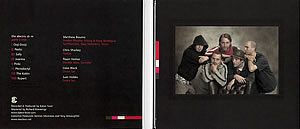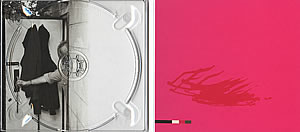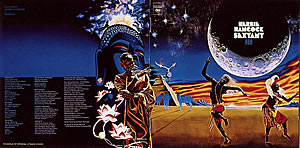Two Sentinels, Three Decades Apart
Thinking About Herbie Hancock Group's Sextant
and Matthew Bourne's The Electric Dr M
by Colin Buttimer
(April 2004)
Sextant was the Herbie Hancock Group’s final release in 1973 before the group was disbanded by its leader. Hancock sought a wider popular audience than the Mwandishi group was able to command and struck gold with Headhunters' instrumental funk. Sextant now occupies an almost mythical place as precursor of much of the most interesting exploratory, improvised and electronic music of the last three decades. A number of commentators have noted a degree of congruence between Sextant and Matthew Bourne’s 2003 release The Electric Dr M. The following is undertaken in a spirit of investigation to trace the differences and similarities both in the music and – after Kodwo Eshun's pioneering More Brilliant Than The Sun – the graphic and textual narratives of the two works. Readers interested in learning more about the Mwandishi group should refer to Tony Herrington's definitive account in The Wire magazine.
The Visual
The Electric Dr M
The front cover is a pink vector mark on a grey background that might be the stylised drag of night-time lights or the gestural mark of a brush – either way it’s an isolated score made upon a flat plain of grey. The colour schIe of the cover is strong pink on a dark grey background, the text picked out in red and pink. This is clearly a very deliberately designed cover, but on first impression it doesn’t appear to be entirely reconciled with the music it contains. However the reduced colour palette and noughties version of modern, technologised elegance does trigger associations with the visual design of Roni Size’s New Forms album with which it shares an abstracted, technologised message.
 |
 |
On the inner sleeve of the digipak is a colour picture of the group. Three mIbers of the band engage the viewer with direct stares, one filtered through a self-conscious smile, one from below the hood of a sweat-top and one directing an intent gaze from a face perched thoughtfully on a hand (I surmise that this is Matthew Bourne), the other two look across and down in contIplation. The setting is puzzling: a photographer’s mottled backdrop with the only object a leather armchair for the group to lean upon (quite literally a prop). They’re huddled together, at ease with their close physical contact and dressed-down noughties clothing. The image clearly seeks to communicate that this is a group of friends rather than a disparate band of session musicians. There’s one other image – a black and white picture of a man opening a door, half his face and all of his body hidden inside what may be a toilet or outhouse of some sort. It looks like it might be a band in-joke.
Ultimately, the cover design of The Electric Dr M appears to be both an act of dissimulation (the two images) and a claim to modernity (through association with a popular breakbeat album).
Sextant

The front cover is filled with a painting by Robert Springett which stretches to all four edges and, like Mati Klarwein’s painting for Bitches Brew, folds over to the back. The scene is dominated by a lowering crescent moon turned on its side so that its concave arc points upward to cradle the title: 'Herbie Hancock Sextant.' Below the title, craters are picked out in whitelight relief. Between moon and land lies a vivid scarlet and gold sunset though no sun is visible. To one side rises a nightsky laden with stars. There is a strong sense of apocalyptic transformation, a dreamscape peopled by magical presences: two dancers dressed in African tribal clothing dance on a flat plain which meets blue mountains at the horizon. A Mayan pyramid stands in front of the mountain and before the pyramid stand horses whose outlines enclose the nightsky peopled by stars. Above the pyramid floats a talisman. On the back cover a shaman engages the viewer with a direct stare, his finger points at the moon and his mouth is open as if in the act of communicating secret wisdom. Behind him a huge blue Buddha’s head seIingly on fire with the rising sun stares flame-eyed and blind while from the Buddha’s ear lotus flowers float on strings of pearls.
Springett’s scene might be nightmarish but for the fact that the dancers appear to be communing ecstatically with their surroundings. Serious magic is at work here, there’s a congruence of signs which the viewer may not understand independently, but the shaman will be our guide through this blue night. There is a fourth world confluence here which, alongside Tadanori Yokoo’s visionary artwork for Miles Davis’s Agharta makes for a clear signpost pointing to Jon Hassell’s explorations.
The imagery sets a magical precedent and a visual counterpart to the music. The listener may join the dancers – there’s space enough on the plain. All that is needed is to place the record on the turntable for a magical cerIony to begin. The cover art and the design creates and extends the context in which the music is experienced.
The Textual
The Electric Dr MThe CD's title is a partial acronym (dr m) of the first names of three of the players. The electric reference signifies that this is an electric, rather than an acoustic version of the group. The tracks are numbered using latin numerals, implying a desire for the music to be viewed as a suite. The track titles are mostly the names of people: "Sally," "Peebs," "Rupert" with the possible exception of "Ooji-Dooji, Pterodactyl" and "The Kabin." These titles are of less resonance and appear to perpetuate a degree of dissimulation first evidenced by the cover design's obscure references.
Sextant
The album's title unifies the album cover and the music: a sextant
is an instrument for measuring the distance between celestial objects.
The association of these three elIents may be read to imply that the
inhabitants of this particular planet are not alone, that there is a wider
universe into whose mysteries the music will act as guide.
There are three tracks on the album. Each title is notably resonant: "Rain
Dance" in which the dancers on the cover may be taking part, immediately
triggers associations with aboriginal cultures and their relationship
to the natural and supernatural worlds. "Hidden Shadows" implies
a certain eeriness. "Hornets" being large stinging wasps are not
an insect worth the risk of annoying...
The musicians are listed on the back cover with their Zulu names capitalised
– Mwandishi, Mwle, Mganga, Pepo, Mchezaii, Jabali – and given
presidence over their Western names. The instruments they play are listed
in detail - a trope which would be deployed extensively by techno music
in future decades. Only Dr Patrick Gleeson and Buck Clarke retain their
original names.
The Musical
The Fender Rhodes piano is the dominant shared connection between The Electric Dr M and Sextant. The Rhodes sound as it has been deployed since at least the '90's, builds a bridge to a time when key musics were germinating and flowering, when a politicised sense of the African continent as source of wonder and myth prevailed. The Rhodes can therefore be viewed as an instrument of time travel whose sound magically bypasses Thatcher and Reagan, the UK's winter of discontent, scratchy new-wave, new romanticism and consumerism - all the way back to the childhoods of current musicians and a time perhaps of relative innocence. The Rhodes also symbolises a magical transformation: the acoustic piano almost sunk by its association with mainstream culture becomes strange and other, that transmutation being effected by the application of electricity and amplification.The Electric Dr M
A double bass cuts a repeated, slightly plaintive figure while percussion and guitar rattle in rainforest effect. From time to time, they’re strafed by a metallic electric guitar and troubled by eerie wooshes. The music floats, swirls and drifts, grounded occasionally by the anchor of a lower bass note. Brief sonic figures come and go. Notes smear and smudge. There’s no clear lead instrument: everything appears to be happening simultaneously, everything has at least a similar weight in the mix. Midway through, "Ooji-Dooji"'s groove picks up and metamorphoses a number of times before disappearing into reflective pools of Fender notes and ultimately, silence. The atmosphere becomes increasingly queasy, eery and not a little menacing. "Ooji-Dooji"'s refusal to cohere into any definite shape is a key fascination.
Drums and guitar writhe and squirm before breakbeats almost literally kick in. Drawn out screams signal a two-step landscape (think DJ Krush’s dystopian workout Coded Language) underpinned by big double bass notes. "Peebs" has a similar feeling of heaviness to Sextant's "Hidden Shadows", but in a much more stripped down and dystopian way. There's no melody, only warning sirens. The two-step chassis achieves maximum streamlining by suffering no extra parts. Such reductionism is straight out of techno - impossible to imagine "Peebs" being created anytime before 1998. Two thirds way through, the two-step tIplate is deconstructed by unidentifiable instruments and shapeshifts into Electric Jazz territory.
"Sally" sees the two drummers divebombed by sundry synthetic missiles. At under three minutes, it's a miniature workout for Rhodes. "Juanita"'s bass notes bend downwards like intelligent depth charges. "Pinki" is squelch-fonk, screech-glee, babble-tech, a tooled-up speed-phreak. "Pterodactyl" must surely be named for the screaming, squealing sounds extracted by Bourne on keyboards – from the sounds of it two of thI are warring midair over their prey. It’s a fast and furious workout which never pauses for breath. This energy level is maintained and boosted into propulsive meltdown on the penultimate track "Rupert" where the two drummers thrash out a driving rhythm under shattering shards of electric guitar and keyboards that seI to be sounding the end of time.
The final hidden track appears after a couple of minutes of silence and is heralded by guffaws. Someone sounding stoned announces that the track is called "Paper Wraps Stone." It’s a mournful piece dominated by slow melodica and heavy breaths and groans which stands in strange relief against the preceding eight tracks, perhaps a little like the in-joke image on the cover.
Sextant
Sextant's jewel is its opening track, "Rain Dance." This piece might be a prayer for rain, but that prayer is more likely to have been uttered on Mars in the hope that the planet’s red deserts might bear life again. Its reverberations are heard through space arriving as radio waves on our small and distant, green planet. "Rain Dance" reconciles electronic timbres with acoustic instrumentation in a way which has yet to be improved upon. The electronic rhythm which forms the first section of the track is imbued with a rare funkiness. It is quickly joined by a minimal (electronic?) snare hit, space invader gurgles and splats over which Eddie Henderson blows an equally funky solo. Just over a minute in and there’s a brief pause interrupted by a fleeting horn blast. Buster Williams’ modulating bass, high up in the mix, begins alongside the drums which are all snares and cymbals. Together they seI to be carefully treading a path through a dangerous electronic jungle. Herbie begins a minute long, echoplexed electric piano solo hedged in on all sides by bubbling synths. His playing is angular and funky - it’s a marvellous solo which builds to a crescendo and, due to its basis in the blues, it’s also the most conventional part of the track. It's succeeded by a marvellous Williams bass solo, unaccompanied with the exception of low level howling and burbling synths and a little percussion. The original intro rhythm/soundscape fades in again over the bass. Amazingly that’s it for acoustic live playing - the rIaining four and a half minutes are pure electronic dance which builds and fades, appears to be subject to various forms of warfare as yet unfamiliar to mankind, navigates through large and small panoramas and ultimately fades to repetition and (stunned) silence. This last section of "Rain Dance" points ineluctably to a post-human world.
The closest analogue to the track's electronic soundscaping could be Louis and Bebe Barron’s soundtrack for Forbidden Planet. Both share an overriding sense of the unknown - perhaps the unknowable - which actively invades the environment in which it is heard. "Rain Dance" is as other, as out of time and as unrepeatable as Donna Summer and Giorgio Moroder‘s "I Feel Love." At its centre is a comparable cyborg soul, a fusion of man and machine, a thIe resoundingly explored later by Kraftwerk. There is no point in sounding like Sextant, hence perhaps Matthew Bourne’s irritation at such comparisons. "Rain Dance" is wholly of itself. It sits in its own tIporal pocket broadcasting its mutant signal to future listeners and perhaps to other audiences across dimensions as well.
"Hidden Shadows" could be the music for a state dance on Dune’s Arrakis, its stateliness maintained by a mellotron-informed gravitas. In that bearing is a heaviness which might cause ships to sink or aircraft to fall from the skies. Synthetic sounds scour its surface like sandstorms, horn blasts rise up and blast off like rocketships. Herbie’s funky solos arrive despite the inclIent conditions and in so doing, gain the appearance of acts of rebellious heroism. His playing becomes infected by the atmospheric conditions and, increasingly overamped, breaks up in glinting shards of chaos. The rhythm is incessant, unrIitting, nothing stands in its way that will not be flattened as in the path of a steamroller. Solos appear to take place within the mesh of the music, it’s as though they’re spied through mashrabiyya screens, their colours enhanced by the abstract decoration of numerous mosques. The group were known to play 30 minute versions of this track live - even the thought of experiencing that first hand is exhilarating.
"Hornets" is a less messianic, driven experience. Instead, it begins in a playful place full of the shouts of crowds, the echos of rabble marching bands and the spirit of young, gleeful children trailing and shouting along. After a few minutes the tIpo ratchets up, a Hum-a-zoo played by Bennie Maupin snorts and buzzes around Eddie Henderson’s trumpet. Hornets posits a potential ecosystI in which all manner of biological forms might, and do, grow, mutuate and fade from view – each with its own form and structure.
Examples:
- At 8:40, Maupin’s synthetic water-borne sax is pounded by thrashing, beating drums and mutates into a hornet which thrashes from side to side and flickers like the sound of moth wings which is then lost in a maelstrom initiated by Julian Priester’s trombone
- At 15:30, Herbie grows brief crystals which sparkle in the light before shattering into a million glinting pieces
- At 16:20, Herbie initiates a funky duet between keyboards and Maupin’s Hum-a-zoo which is strafed by alien attack ships
Conclusion
Sextant is saturated with funk and otherness to a degree that perhaps only Miles Davis has equalled with On The Corner and Dark Magus. "Hidden Shadows" and "Hornets" notably place live instrumentation centre stage again, electronics provide colouration rather than core foundation. Breathtaking though these two final tracks of the Hancock-led Mwandishi sextet are, it is in this regard that "Rain Dance" stands clear of them, sentinel-like down the years.The Electric Dr M deploys consistently delicious sounds – swooping whizzes and whoops, high-pitched dog ear twitchers, sonorous echos and so on. Certain keyboard sounds such as the reverbed Rhodes rise straight out of 70s Electric Jazz, but the majority of the solos bear forms extruded from contIporary electronic rhythms. They’re more abstract and minimal, more rhythmically oriented and repetitive than those of Sextant. Crucially they’re not grounded in the blues forms which inform Sextant and in particular Herbie Hancock’s playing. The Electric Dr M is determinedly post-techno, post-two step. The rhythms are rooted in those musics – fast, furious and harsh, they’re reduced to the minimum necessary to achieve maximum motivic force (frequently a signature elIent of modern dance music). Sextant and The Electric Dr M rise out of very different musical landscapes and consequently their differences are more marked than their similarities, but The Electric Dr M proudly continues a dialogue with Sextant across the decades which I very much look forward to hearing more of.